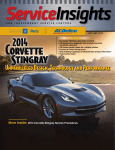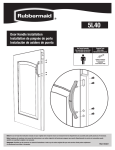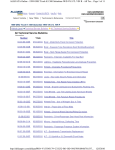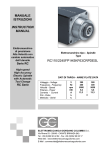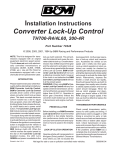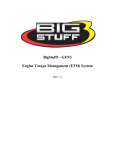Download Simple Shift Installation and Tuning Guide for GM Trans Rev 1.2
Transcript
Installation and Tuning Guide for GM Transmissions Powertrain Control Solutions, LLC. 10511 Old Ridge Rd. Ashland, VA 23005 Phone: (804) 227-3023 Fax: (804) 227-3005 www.PowertrainControlSolutions.com Page | 1 Simple Shift Installation and Tuning Guide Thank you for purchasing your Simple Shift! We understand how important it is for our product to perform flawlessly in order for your vehicle to operate to its full potential. We appreciate the trust you’ve put in us and want to assure you that by following this Instruction Manual and Tuning Guide you will be completely satisfied. It’s just that simple… Simple Shift! How to use this manual This manual is designed to be a step by step guide to installing and tuning the Simple Shift transmission controller. There are two main sections, Part 1 – Simple Shift Installation Guide, and Part 2 – Simple Shift Tuning Guide. Each section is broken down into steps. Follow the steps in order and do not skip any steps. Throughout the manual there will be “You need to know” and “Important Note” reference sections that should be read and fully understood before continuing. At the end of this manual will be a Troubleshooting and Diagnostics Guide in case you run into any issues during your installation. What you should have Now that you have opened your Simple Shift packaging you should have the following: • • • • Simple Shift Transmission Control Unit Main Harness Main Harness Grommet (3) Blue and (1) Gray Connector Locks For carbureted applications, a Remote Mount TPS Adapter Kit is included in the Simple Shift Carb kit or available from PCS, part number TCM-6000. If any of these parts are missing or damaged contact your dealer before you continue. Tools you may need To install your Simple Shift properly the following tools may be required: • • • • • • • • • • Half-round file or de-burring tool Simple Wiring Tools 5/16” wrench 7/16” wrench 1/2” wrench Phillips screwdriver Flat screwdriver 1-3/8” hole saw or 1” Conduit Punch-out – the required inner diameter of the hole to use the included grommet is 1-3/8”. Mounting Hardware (Bolts, Screws, Velcro, etc.) Service Manual or Wire Diagrams for your vehicle Powertrain Control Solutions, LLC. Rev 1.2 804.227.3023 Simple Shift Installation and Tuning Guide Page | 2 Part 1: Simple Shift Installation Guide Step 1: Find Mounting Location for your Simple Shift Your Simple Shift unit should be mounted inside the vehicle to protect it from the elements and on a flat surface to avoid distorting the case. Your Simple Shift should be protected from excessive heat and vibration. Determine the best place to mount your Simple Shift then move on to step 2. It is recommended that you leave it un-mounted to make it easy to access/adjust until after the tuning process is completed, especially if you plan to mount it in an inconspicuous place such as under the dashboard or inside/behind a console or glove box area. Step 2: Cut Main Harness Access Hole Once you have decided on a place to mount your Simple Shift unit, you can now locate where the main harness access hole will need to be. A typical location for the main harness access hole is through the firewall, just above the transmission tunnel and toward the passenger side of the vehicle. (See Figure 1) That should allow the main harness to reach the transmission, engine, and battery without cutting or modifying the harness. IMPORTANT NOTE: If installing in large or long vehicles such as trucks, read ahead to step 4 – Install the harness before locating or drilling an access hole. This will assure you have enough harness length to properly install your Simple Shift. If you do not have an available access hole, you will need to use a 1-3/8” hole saw or punch set to cut a hole in the firewall. This 1-3/8” hole will allow the purple Simple Shift connectors to pass through the firewall easily. It is highly recommended that you use a file or other type of de-burring tool on the edges of the access hole to avoid scuffing or tearing the wiring behind the purple Simple Shift connectors when pushing them through the access hole IMPORTANT NOTE: Before cutting the access hole, first cover the area with masking tape. This will help reduce the chance of scratching the area around the hole during the cutting process. Powertrain Control Solutions, LLC. Rev 1.2 804.227.3023 Page | 3 Simple Shift Installation and Tuning Guide Step 3: Assemble Simple Shift Connectors At the end of your main harness, there are two purple connectors of similar shape but different in width. These two connectors will be pushed through the access hole and into the vehicle with your Simple Shift unit. 1. Holding one of the purple connectors, carefully bend the wiring flush with the back of the connector. Be very careful so none of the wires are pulled out of their cavities. Feed it through the access hole. Be careful that you do not damage the wires while feeding them through the access hole. (See Figures 2 and 3). Repeat for the next connector. 2. In order to minimize the hole-size required to feed the harness through, we have shipped the harness without installing the locks for the connectors. There are (3) blue and (1) gray lock (See Figure 4). Carefully insert the locks one at a time, paying close attention to their proper alignment (See Figure 5). When the locks have been pushed in completely the lock clips will be engaged and will not pull back out (See Figure 6). Repeat this step for all four locks. DO NOT plug the purple connectors into the Simple Shift unit yet. This will be done once the harness has been completely installed. Powertrain Control Solutions, LLC. Rev 1.2 804.227.3023 Page | 4 Simple Shift Installation and Tuning Guide Step 4: Install the Harness The Simple Shift Main Harness has been designed to be very easy to install. Each connector is clearly labeled and each heading in the section below reads exactly the same as the labels found on its corresponding connector or wire in the Main Harness. All connector labels below in BOLD are required for transmission operation. • • TRANSMISSION CONNECTOR - This connector is required for operation of your Simple Shift unit. See Table 1 Transmission Reference Chart and the corresponding Figure for your transmission connector location. Transmission Figure 4L60E 1993-96 4L60E 1997-UP 4L65E 4L70E 4L80E 4L85E 5L40 5L50 Figure A Figure B Figure B Figure B Figure C Figure C Figure D Figure D OUTPUT SHAFT SPEED SENSOR – This connector is required for operation of your Simple Shift unit. For all transmissions that have an Output Shaft Speed Sensor we Table 1 - Transmission Reference Chart have added a ‘Y’, which allows you to plug the Simple Shift harness directly into the transmission yet still leave you an access plug for aftermarket speedometers or factory connectors of some kind that need Output Shaft Speed Sensor access. See Table 1 and the corresponding Figure for your output shaft speed sensor connector location IMPORTANT NOTE: 4L60E transmissions have a different output shaft speed sensor connector on early models (1993-1996) than they do on later models (1996-Up). The harness will take either style. You will find two mini-harnesses tied to your main harness at the output shaft speed sensor connector. Simply use one of the two clearly labeled mini-harnesses that fit your application. • INPUT SHAFT SPEED SENSOR - Only found on 4L80E and 4L85E transmissions. If equipped, this connector is required for operation. See Figure C for connector location. Powertrain Control Solutions, LLC. Rev 1.2 804.227.3023 Page | 5 Simple Shift Installation and Tuning Guide Step 4: Install the Harness (continued) • THROTTLE POSITION SENSOR - this connector is required for operation. FOR ELECTRONIC FUEL INJECTED APPLICATIONS: For cable-driven type throttle bodies you will want to splice into the existing throttle position sensor wiring. Connect your throttle position sensor wiring according to the chart below. Proper wiring techniques can be found on the support page at www.powertraincontrolsolutions.com. Once you have completed this step you can skip to BRAKE LAMP INPUT. Simple Shift TPS Wire Color Red/White Yellow/Black Black/White Function +5V Power Signal Ground Connect To DO NOT USE if sharing sensor with ECU Your TPS signal wire Your TPS ground wire IMPORTANT NOTE: DO NOT connect the TPS to a drive-by-wire throttle position sensor in any way. Contact your dealer for information on how to install a separate throttle position sensor in this case. FOR CARBURETED APPLICATIONS: If you have a carbureted application and need a throttle position sensor, a Remote Mount TPS Adapter Kit is included in the Simple Shift Carb kit or available from PCS, part number TCM-6000. What you should have • 1 – Cable assembly with TPS sensor mounted on bracket • 1 – Universal kickdown cable bracket • 1 – bag of mounting hardware for TPS bracket (includes 3 bolts, 3 nuts, 3 spacers, and a drill template) Mounting your Remote TPS Adapter Carburetor Kickdown Cable Bracket – If your carburetor has a kickdown cable bracket then you can skip to Step 6 below. If it doesn’t then you’ll need to install the Universal Kickdown Cable Bracket supplied with this kit. The Universal Kickdown Cable Bracket installs very simply by using the rear carburetor mounting bolt on the same side of the carburetor as the throttle lever. The bracket is held down by the bolt and steadied by the flange and set screw found on the bracket beside the mounting hole. To install: 1. Remove the existing throttle cable bracket. 2. Remove the carburetor mounting bolt behind the throttle lever. 3. Using the carburetor mounting bolt, install the bracket as shown in Figure E. It may require you to loosen the set screw before the bracket sits flat on the carburetor mounting flange. Do not tighten the carburetor mounting flange bolt completely yet. Powertrain Control Solutions, LLC. Rev 1.2 804.227.3023 Simple Shift Installation and Tuning Guide Page | 6 Figure E 4. Now tighten the set screw until the kickdown bracket flange pushes up against the back of the carburetor mounting flange tightly. 5. Tighten the carburetor mounting flange bolt. 6. Take the cable end of the remote TPS adapter assembly and push it through the kickdown cable mounting hole shown in Figure F until it clicks into place. Figure F IMPORTANT NOTE – If you relocate your throttle cable to the universal kickdown bracket make sure it moves freely, drops back all the way to idle, and does not over-sweep past wide open throttle. Severe damage could occur if proper adjustment is not performed. Figuring out where to mount your TPS adapter - Your Remote TPS Adapter has been designed to easily mount out of the way for a clean looking installation. It can be mounted along the firewall, the inner fender area, or even in the transmission tunnel area. One thing to remember is you’ll want to mount it in a place that is easy to access and is within reach of both the TPS connector on your Simple Shift harness and the kickdown cable mounting location on your carburetor. To accomplish this, you may need to loosen the brass adjusting nut on your cable assembly. It can usually be loosened by hand but if need be a 1/2” wrench can be used (see Figure G). Powertrain Control Solutions, LLC. Rev 1.2 804.227.3023 Simple Shift Installation and Tuning Guide Page | 7 Figure G TPS Sensor end – This end of the cable assembly will be mounted with the bolts, spacers, and nuts found in your hardware bag. Use the drilling template found at the end of these instructions as a template to drill the three ¼” holes required to mount this bracket. Use the spacers between the bracket and the mounting location on your vehicle. Connecting your Cable – You can now attach the cable to your throttle lever assembly. There are three ways to connect your TPS adapter cable to your throttle lever assembly. They are: 1. Using the black clip adapter on a shouldered stud found on your throttle lever 2. Using the silver lever adapter on screw-headed stud found on your throttle lever 3. Using the cable itself running through a hole in the stud on your throttle lever Whichever attachment method works best for your application is easily installed by taking a flat blade screwdriver and loosening the brass stop found on the end of the cable. Once you have loosened the stop you can slide it off and add whichever attachment method is appropriate for your application. Now slide the brass stop back on the cable and you are ready to adjust the cable for proper length. Adjusting your cable – Your cable must be adjusted properly to assure correct operation of your Simple Shift. To adjust your cable: 1. Move your throttle lever to just slightly open and tighten the brass stop on the cable tightly against the mounting stud. This keeps tension on the cable at all times and allows the Simple Shift to know where your lowest throttle point is. 2. While watching the TPS switch on the end of your cable assembly closely, open your throttle to wide open throttle. Watch your TPS switch very closely. What you want to see is for it to keep moving until your throttle lever stops moving. If your TPS switch stops moving before your throttle lever stops you must adjust the lever on the TPS switch. This lever can be easily adjusted by taking a small phillips screwdriver and loosening the screw found on the TPS switch lever. The lever will slide off the TPS switch, allowing you to slide the cable out of the mounting hole in the lever and move it to another hole allowing more movement of the lever. Powertrain Control Solutions, LLC. Rev 1.2 804.227.3023 Simple Shift Installation and Tuning Guide Page | 8 Connecting your TPS connector - You can now connect the THROTTLE POSITION SENSOR connector found in your Simple Shift harness to the TPS sensor on your remote TPS cable assembly. • BRAKE LAMP INPUT - This is required to unlock your torque converter when you step on the brake pedal. This wire should see +12v when your brake pedal is pressed. Tap into the brake light circuit. See the service manual or wiring diagrams for your vehicle. • SPEEDOMETER -This wire is not required for operation of your Simple Shift unit. Its purpose is to deliver a signal to early, older versions of electronic speedometers. Most aftermarket speedometers will use the Output Shaft Speed Signal found previously in these instructions. If your speedometer will not work with the Output Shaft Speed Signal contact your dealer for technical assistance. • TACHOMETER - This wire is not required for operation of your Simple Shift unit but it is recommended to offer comprehensive diagnostic capabilities. To utilize the full diagnostic function of your Simple Shift, connect this wire to the tachometer output wire of your ignition system. The TACHOMETER GROUND wire must also be connected when the tachometer wire is being used. Connect this wire to a ground on the vehicle. • PCS EXPANSION - This connector is not required for operation of your Simple Shift unit. It allows optional equipment, such as the Paddle Shifter or the D200 Touchscreen Dash logger, to be connected to your Simple Shift system. Instructions on how to utilize this connector will be included in the instructions for the optional expansion kits. • OPTIONAL COM NOT REQUIRED FOR USE - This connector is not required for operation of your Simple Shift unit. It would only be utilized to communicate from the Simple Shift to our proprietary software for custom calibrations. • +12V BATTERY -This wire is required for operation of your Simple Shift unit. It needs to be connected to the positive terminal of your vehicles battery. If this is not connected properly the Simple Shift unit will lose its TPS calibration and will not store diagnostic codes. • SWITCHED +12V - This wire is required for operation of your Simple Shift unit. It needs to be connected to the ignition/start system of your vehicle. It must have +12 volts while in both the start and run positions and no power while in the off position. If this is not connected properly the Simple Shift unit will not turn on and off correctly. • CHASSIS GROUND - This wire is required for operation of your Simple Shift unit. It should be connected to ground on the chassis of your vehicle or directly to the negative post of your battery. Step 5: Connect the Simple Shift 1. Now that you’ve installed the main harness it’s time to connect to your Simple Shift unit. Simply push both of the purple connectors into their corresponding-sized cavities until they click into place. Powertrain Control Solutions, LLC. Rev 1.2 804.227.3023 Page | 9 Simple Shift Installation and Tuning Guide Step 6: Install Main Harness Grommet Now that you’ve installed your main harness and Simple Shift unit, the main harness grommet can be installed to keep unwanted air and moisture from getting through your main harness access hole. First, you must cut the grommet so it can be wrapped around the harness just outside the access hole. Next, start on one end of the cut and push the grommet into the access hole, pressing tightly with your thumbs or forefingers as you work around it in a circle and into place. YOU ARE NOW READY TO MOVE ON TO PART 2 – SIMPLE SHIFT TUNING GUIDE Part 2: Simple Shift Tuning Guide Step 1: Initial Knob Adjustment Figure 10 - Baseline Knob Configuration Before driving the vehicle, the Simple Shift knobs must be set to a baseline configuration as shown in Figure 10 and described below. 1. Set low shift point knob to 0. 2. Set high shift point knob for approximately 500 RPM below the maximum RPM of your engine. Refer to Table 1. 3. Set low shift firmness knob to 7. 4. Set high shift firmness knob to 7. 5. Set low converter lock knob to 0. 6. Set high converter lock knob to 0. 7. If engine RPM is connected to the Simple Shift, set the number of cylinders. If engine RPM is not connected, set this knob to Off. High Shift Point Knob Setting -7 -6 -5 -4 -3 -2 -1 0 1 2 3 4 5 6 7 Approximate Shift RPM 2500 2850 3200 3575 3925 4275 4650 5000 5350 5700 6075 6425 6775 7150 7500 Table 2 - High Shift Point Table Powertrain Control Solutions, LLC. Rev 1.2 804.227.3023 Simple Shift Installation and Tuning Guide Page | 10 Step 2: Simple Shift Functional Verification 1. Turn on Simple Shift – Place key in Run position without starting the engine. Verify the Simple Shift is turning on by confirming the Diag light is powered (either green or red). If the light does not turn on, refer to the troubleshooting guide. Do not continue with the functional verification until the Simple Shift turns on with the key. 2. Calibrate Throttle - To calibrate the throttle specifically for your vehicle, the Simple Shift must see the full range of the throttle. With the key in Run position and engine not running, depress the throttle from rest position to full throttle and release. IMPORTANT NOTE: Throttle calibration must be performed every time the Simple Shift loses a constant +12V supply, such as a battery disconnect, or if Simple Shift is unplugged from the harness. Failure to perform this calibration will result in inconsistent shifts and may damage the transmission. 3. Verify Throttle - Refer to Figure 11 for the location of the Diagnostic (Diag) light and the Status light. To verify the throttle is calibrated watch the Status light (bottom light). The light should be very dim or off while the pedal is released. The light should flash faster with increasing throttle. The light should be solid green when the pedal is fully depressed. The Status light will be solid red while the vehicle is not moving if there is a TPS trouble code set. Figure 11 - Diag and Status Lights 4. Check for Trouble Codes – Check the Diag light. If it is solid green then continue to the next step. If it is flashing red, refer to the troubleshooting guide before continuing. IMPORTANT NOTE: The following steps require looking at the Simple Shift’s Status and Diagnostics lights. This requires a person to drive and a person to look at the Simple Shift. DO NOT attempt to drive by yourself and continue with the functional verification or calibration 5. Verify Vehicle Speed - Start the vehicle. Place the vehicle into Drive and drive at a slow speed with little throttle. Look at the Diag light. It should flash green relative to vehicle speed. Only drive fast enough to verify the Simple Shift is reading vehicle speed. If the Diag light does not flash, refer to the troubleshooting guide. If it flashes red, but increases with vehicle speed, then your vehicle speed is working, but there are trouble codes on the Simple Shift. Diagnose the trouble codes before continuing. Powertrain Control Solutions, LLC. Rev 1.2 804.227.3023 Page | 11 Simple Shift Installation and Tuning Guide 6. Verify Shifting – While the vehicle is moving slowly (driving in first gear), observe the Status light. This light flashes the current gear. Increase speed slightly so the transmission shifts from 1st to 2nd. You should feel the transmission shift and the Status light should now flash twice to indicate 2nd gear. If the transmission doesn’t shift, or the Status light doesn’t change, refer to the troubleshooting guide. You Need to Know - Understanding the Diag Light and the Status Light The Diag and Status Lights are used to provide feedback of the current state of the Simple Shift. The lights provide different information when the vehicle is moving or not moving. The table below provides a summary of the light functionality. Figure 13 - Diag and Status Lights Diag Light Vehicle not moving (Vehicle speed not detected) Vehicle moving • Solid green: No trouble codes present • Flashes red: Flashes the trouble code number which is described in the troubleshooting guide. • Flashes green: Flashes relative to vehicle speed – no trouble codes • Flashes red: Flashes relative to vehicle speed – trouble codes are present • Flashes green: Flashes relative to throttle position (off at 0% TPS, solid green at 100% TPS) • Solid red: TPS trouble code set • Flashes green: Flashes relative to current gear – torque converter unlocked • Flashes red: Flashes relative to current gear – torque converter locked Status light Step 3: Simple Shift Calibration 1. Check for Trouble Codes – During tuning, the Simple Shift should be monitored for trouble codes. If at any point the Diag light flashes red, then trouble codes are present. Refer to the troubleshooting guide and do not continue until the trouble codes are diagnosed and resolved. You Need to Know – Understanding how the Low and High knobs work together The Simple Shift is programmed with a specific calibration for your transmission. Based on your engine, vehicle, and personal preference you will use the high and low knobs to trim shift points, shift firmness, and torque converter lockup. The effect the knobs have on the calibration are based on throttle position. At 0% throttle, the Low knob controls the calibration. At 100% throttle, the High knob controls the calibration. At throttle positions between 0 and 100%, the knobs act together with each contributing some control over the calibration based on the throttle position. At 50% throttle position, both knobs contribute 50% control over the calibration. Powertrain Control Solutions, LLC. Rev 1.2 804.227.3023 Simple Shift Installation and Tuning Guide Page | 12 Step 3: Simple Shift Calibration - continued 2. Full Throttle Shift Points - This must be done under a controlled environment such as a drag strip or a chassis dyno so no speed limits are exceeded. Shifts are going to occur at approximately the same RPM for each shift; therefore you may only need to make adjustments using the 1st to 2nd shift as a test. If you need the shift to happen at a lower RPM, turn the knob counter clockwise toward the negative numbers. If you need the shift to occur at a higher RPM, turn the knob clockwise toward the positive numbers. Table 2 is provided as a reference, but the actual engine RPM will vary with torque converter stall speed. Figure 12 - Full throttle shift points 3. Full Throttle Shift Firmness - The knob was set to 7 during the initial setup. This setting is the maximum shift firmness. If the knob is set to 7 and the transmission is slipping, discontinue driving immediately and contact your dealer. If the full throttle shift firmness needs to be decreased, rotate the knob counter clockwise. If the full throttle shifts need to be firmed up, increase the shift firmness by rotating the knob clockwise. When making adjustments, turn the knob by one position then retest. Repeat as necessary. Keep in mind that a softer shift may result in higher engine RPM during the shift, therefore you may have to adjust your high throttle shift point selected in the previous step. Figure 14 - Full throttle shift firmness 4. Low(light) Throttle Shift Points - Drive the vehicle at light throttle and adjust the low throttle shift points as necessary. Rotate the knob clockwise to make the shifts occur at a higher RPM. Rotate the knobs counter clockwise to make the shifts happen at a lower RPM. Figure 15 – Low(light) throttle shift points Powertrain Control Solutions, LLC. Rev 1.2 804.227.3023 Simple Shift Installation and Tuning Guide Page | 13 Step 3: Simple Shift Calibration - Continued 5. Low(light) Throttle Shift Firmness - The knob was set to 7 during the initial setup. This setting is the maximum shift firmness. If the knob is set to 7 and the transmission is slipping, discontinue driving immediately and contact your dealer. Drive the vehicle at light throttle and adjust the light throttle shift firmness as necessary. If the light throttle shift firmness needs to be decreased, rotate the knob counter clockwise. If the light throttle shifts need to be firmed up, increase the shift firmness by rotating the knob clockwise. Figure 16 – Low(light) throttle shift firmness 6. High Throttle Torque Converter Lockup – The Simple Shift’s Status light indicates when the torque converter is locked up. While moving, the Status light flashes the current gear. If the light is flashing green, then the converter is unlocked. If the light is flashing red, then the converter is locked. To lockup at a slower speed, turn the knob counter clockwise. To lockup at a faster speed, turn the knob clockwise. Figure 17 - Full throttle converter lockup 7. Low(light) Throttle Torque Converter Lockup - To lockup at a slower speed, turn the knob counter clockwise. To lockup at a faster speed, turn the knob clockwise. Figure 18 – Low(light) throttle converter lock Congratulations!!! You are now ready to enjoy your new Simple Shift! Powertrain Control Solutions, LLC. Rev 1.2 804.227.3023 Page | 14 Simple Shift Installation and Tuning Guide Troubleshooting and Diagnostic Code guide Troubleshooting Diag light does not turn on with the key - The Diag light will turn on when the Simple Shift has the following connections: Wire Color Yellow Red Black Connect To Switched +12V Constant (Battery) +12V Chassis Ground Simple Shift Pin C16 A12 C1, C2 With a volt meter, verify voltage at Pin C16 and A12 of the Simple Shift Connector. Verify a good ground by measuring continuity between C1, C2 and chassis ground. The switched +12V and the battery +12V are fused in the harness. If voltage is not measured at the appropriate pins, check the fuses first. If voltage is found at the appropriate pins and there is a good ground, disconnect all connectors, such as TPS, transmission, VSS, etc until there is only power and ground going to the Simple Shift. If the Simple Shift still does not power up, contact your Dealer or PCS Support. If the Simple Shift does power up, connect each connector one at a time to isolate which connection is causing the issue. When the problem connector is found, refer to the wiring schematic for your Simple Shift harness. If the problem can not be found, contact your Dealer or PCS Support. Diag light is always on even when the key is off - If the Diag light does not turn off, check the yellow switched +12V input to the Simple Shift. This wire should only connect to +12V when the key is on. Status light does not change with throttle – When the vehicle is not moving, the Status light should flash green at different rates based on throttle position. At full throttle, the light should be solid green and at no throttle the light should be very dim green or off. The Status light will be solid red while the vehicle is not moving if there is a TPS trouble code set. Check the Diag light to see which code is set. Status light is solid at no throttle and goes dim with more throttle. The Status light must get brighter with more throttle. If it is on at no throttle and gets dim with increasing throttle, the TPS +5v and ground are swapped or is the wrong type of sensor. This can be corrected by swapping the +5V wire (Red with white stripe) and the sensor ground wire (Black with white stripe) at the sensor. Diag light does not flash with vehicle speed when the vehicle is moving. The diag light flashes according to vehicle speed. If the Diag light does not flash when the vehicle is moving the transmission may remain in 1st gear. Verify the Output Shaft Speed Sensor connector is connected correctly. If another device is connected to the ‘Y’ cable disconnect it and verify the Diag light flashes with speed. If still no flashing occurs test the sensor per the factory service manual. Powertrain Control Solutions, LLC. Rev 1.2 804.227.3023 Page | 15 Simple Shift Installation and Tuning Guide Transmission does not shift. For the controller to command a shift, it requires power, ground, and vehicle speed. Power and ground can be verified by observing that the Diag light turns on. Vehicle speed can be observed from the Diag light. As vehicle speed increases, the Diag light should increase the rate of flashing. If the status light flashes a different gear but no shift was felt verify the transmission has power at the solenoid connector. If power is present but no shifting occurs have the transmission checked by a qualified transmission service facility. Diagnostic Code List Simple Shift includes a complete list of OE-style diagnostic codes that have been programmed to include ‘limp modes’ so that you do not get stranded if at all possible when the worst occurs. These codes can be viewed on your Simple Shift through the Diag light found on the end panel of your Simple Shift control unit and are invaluable pieces of information for the transmission professional or knowledgeable do-it-yourselfer. Important Note - Codes 24,39,68,69,71,74,75 are disabled if RPM knob is set to 0 Important Note - Codes 74,85,86,87 do not apply to 4L60E Code Name 21 Throttle Position High 22 Throttle Position Low 24 Output Speed Sensor 28 Range Pressure Switch 37 Brake Switch Stuck Off 38 Brake Switch Stuck On 39 TCC Stuck Off 52 System Voltage High Long Conditions for code Throttle position voltage has been above 4.9 Volts for more than 1 second. TPS voltage is less than 0.20 volts for more than 6 seconds. Not in Park or Neutral, Engine RPM greater than 3000, Input shaft speed greater than 2800, Throttle position greater than 10%, Output Speed Less than 200. All condition met for 3 seconds. PCM/TCM must see one of two illegal combinations from pressure switch manifold. Sets when Brake is not pressed, Vehicle speed is between 5 and 22 mph for greater than 6 seconds, then Vehicle speed is greater than 20 mph for greater than 6 seconds, for a total of 7 times. Sets when Brake is pressed, Vehicle speed is greater than 20 mph for greater than 6 seconds. Vehicle speed is between 5 and 22 mph for greater than 6 seconds, for a total of 7 times. TCC slip is greater than 65 RPM for 2 seconds. Sets when system voltage is greater than 16 volts for 10 minutes. Powertrain Control Solutions, LLC. Rev 1.2 Default condition on fault Maximum line pressure. Shift points fixed at 35% throttle. Maximum line pressure. Shift points fixed at 35% throttle. 2nd Gear with Maximum line pressure. Maximum pressure. Assume Overdrive 4 is selected. None. None. None. 2nd Gear with Maximum line pressure. Inhibit TCC. 804.227.3023 Page | 16 Simple Shift Installation and Tuning Guide 53 58 59 68 System Voltage High Trans Temp High or TFT circuit short to ground Trans Temp Low or TFT Circuit open circuit Component Slipping 69 TCC Stuck On 71 Engine Speed Circuit Low 72 Intermittent Output Shaft Speed 73 Pressure Control Circuit 74 75 79 81 Input Speed Sensor Circuit System Voltage Low Transmission Fluid Overtemp 2-3 Shift Solenoid Circuit Fault 82 1-2 Shift Solenoid Circuit Fault 83 TCC Solenoid Circuit Fault Voltage is above 19.5 Volts for longer than 30 seconds. Transmission temperature must be above 151 Deg. C (304 Deg. F) for 5 second. Transmission temperature must be below -37 Deg. C (-34 Deg. F) for 1 second. No DTC 21,22,71,74. Engine speed is 200 RPM (or more) than input speed for two seconds when in 4th gear and TCC engaged. No DTC 21,22,71,74. Sets when TCC slip is between -25 and 25 RPM, TCC solenoid is commanded off, TPS is greater than 25%. Sets when Engine speed is less than 50 RPM, transmission range is R,D4,D3,D1 for 2 seconds. Sets when Engine RPM is greater than 300, range is D4,D3,D2, or D1, Throttle position is greater than 25% and Output shaft speed changes more than 500 RPM in one measurement period. Force motor current is more than 0.16 Amps different than commanded current. No DTC 75. Sets when Range is not park or neutral, engine speed greater than 200 RPM Output speed greater than 200 RPM, Input speed less than 50 RPM, for 2 seconds. Sets when the ignition is on, voltage is less than the following table: 2nd Gear with Maximum line pressure. Inhibit TCC. TCC always commanded in 3rd and 4th gear. Inhibit TCC. Maximum line pressure. None. None. 2nd Gear with Maximum line pressure. Maximum line pressure. None. 2nd Gear with Maximum pressure. Inhibit TCC. -40F (-40C) = 7.3 volts 194F (90C) = 10.3 volts 302F (150C) = 11.7 volts Engine Speed is greater than 1000 rpm for 4 seconds. No DTC 58. Sets when transmission fluid temperature is greater than 295F (146C), for 30 minutes. PCM\TCM detects an open circuit, short to battery, short to ground, or over-current condition on the shift solenoid “B” circuit. PCM\TCM detects an open circuit, short to battery, short to ground, or over-current condition on the shift solenoid “A” circuit. PCM\TCM detects an open circuit, short to battery, short to ground, or over-current condition on the shift solenoid “A” circuit. Powertrain Control Solutions, LLC. Rev 1.2 None. 2nd and 3rd gears only or 1st and 4th gear only. 2nd and 3rd gears only or 1st and 4th gear only. Inhibit TCC operation. 804.227.3023 Page | 17 Simple Shift Installation and Tuning Guide 85 86 87 Undefined Ratio Error Low Ratio Error High Ratio Error No DTC 21,22,24,38,71,72,87. Sets when TPS is greater than 25%, not in P,N,or 4th, Engine speed is greater than 300 rpm, Vehicle speed is greater than 7mph, Ratio falls out of following table for 2 seconds. Gear 1 2 3 REV Low Limit 2.38 1.43 .95 1.97 High Limit 2.63 1.58 1.05 2.17 No DTC 21,22,24,38,72,74. Sets when not in P,R,N, RPM is greater than 300rpm, TPS is greater than 25%, VSS is greater than 7mph, Transmission ratio matches 3rd or 4th when 1st or 2nd gear is commanded, for 6 seconds. No DTC 21,22,24,38,72,74. Sets when not in P,R,N, RPM is greater than 300rpm, TPS is greater than 25%, VSS is greater than 7mph, Transmission ratio matches 1st or 2nd gear when 3rd or 4th is commanded, for 6 seconds. Powertrain Control Solutions, LLC. Rev 1.2 2nd Gear with Maximum line pressure. 2nd Gear with Maximum line pressure. 2nd Gear with Maximum line pressure. 804.227.3023


















